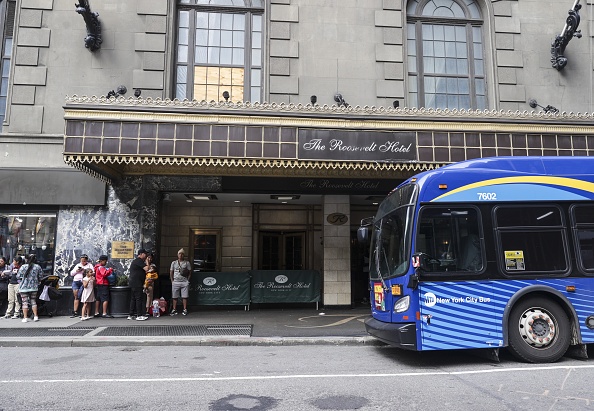Migrant Crisis a Lifeline for New York City Hotels
The city is prepared to pay to house migrants in hotels for the next three years. Many hotel owners are fine with that.
By Aaron Short February 26, 2024 11:25 am
reprints
Hotels are doing their part to accommodate the more than 178,000 asylum seekers who have arrived in New York City over the past two years, but the Adams administration is still struggling to rein in the cost to shelter them.
The city has spent $1.45 billion on migrants over the 2023 fiscal year, and once estimated that the cost of housing migrants could balloon to $9 billion over the next two years and $12 billion over the next three.
But droves of immigrants arriving in New York from the country’s southern border at unpredictable intervals have made arranging accommodations for thousands of new arrivals expensive and challenging. That’s led the city to rely on scores of hotels to provide about 16,000 rooms to migrant families as officials sort out long-term solutions to the population surge.
“We have to have plans to ensure we have space available when needed,” said Murad Awawdeh, executive director of advocacy group the New York Immigration Coalition. “That’s what the hospitality industry did at the forefront of the increase in recent arrivals. We have to think about our collective ecosystem and be prepared to respond to any issue that needs attention.”
In light of these escalating expenses, Mayor Eric Adams trekked to Albany and Washington, D.C., for much of the past year begging state and federal lawmakers to boost their share of the city’s migrant budget.
The state is already allocating $2 billion to housing, food and other services through April while reimbursing the city for 30 percent of the cost toward housing asylum seekers, state budget officials projected. During her State of the State address in January, Gov. Kathy Hochul proposed allocating $2.4 billion out of her $233 billion budget to help the city manage migrants.
Instead, Mayor Adams demanded even more money.
Adams asked state lawmakers to shoulder half the city’s annual costs for caring for asylum seekers — amounting to $4.6 billion through 2025.
“I think there’s a realization that New York City and New York State is going to have to address this issue, and we’re saying it should not be all on the backs of New York City residents,” Adams said at a state legislative budget hearing in February.
Some lawmakers were skeptical that City Hall would spend the money efficiently, especially as the city has continued to rely on hotels paid through emergency “no-bid” contracts with little oversight.
“Relying on hotels is not a sustainable strategy,” said state Sen. Jessica Ramos of Queens. “It is laudable that the hotels stepped up in the early stages of this immigration wave, but now we are almost two years in and need to adjust our approach because we have wasted a lot of time.”
Shuttling migrants into hotels was once seen as an emergency maneuver, but the city is prepared to keep new arrivals in rooms for the next three years.
The city’s most recent contract with the Hotel Association of New York City (HANYC), a hospitality trade association, for between September 2022 and August 2023 disbursed $237 million in rental fees to a little over 100 hotels, according to contract records from the city comptroller’s office. Migrants are currently living in roughly 16,000 rooms, taking up about 12 percent of the city’s hotel occupancy, HANYC said.
Hotel leaders say the expenses are necessary to keep up with the influx of migrants arriving in the city.
“Basically, for all of 2023, we’ve had this issue and we don’t know when it’s going to taper off,” Vijay Dandapani, HANYC’s president and CEO, said. “Each state adopts a different policy on how to deal with migrants, and New York has been targeted in some way. We have our own policies that allow people to come here.”
Then, last fall, the city quintupled its next contract with HANYC to $1.37 billion and extended it through 2026, the New York Post reported.
City officials explained that they extended the contract to help manage the surges of immigrants more effectively as they funnel migrants into other shelters, such as the former Creedmoor Psychiatric Center in Queens and Brooklyn’s Floyd Bennett Field. The hotel contract, which doesn’t include payments to shelters or city-owned sites, allows the city an out if fewer rooms are needed in the future.
“We have dramatically slowed the pace of growth of our hotel footprint. But we also know it will take some time to transition to other kinds of shelters,” Department of Social Services Commissioner Molly Wasow Park told City Council members at a hearing in September. “We want to do it one time instead of year by year so we have some predictability.”
In the meantime, the city is paying hotels where migrants are staying between $175 to $190 per room. Room rates vary widely depending on the season. In mid-February, the average rate for all hotels was $153 per night, while rooms rented during the last week of December at the peak of the holiday travel rush cost $411 per night, according to HANYC data.
But migrant families can remain in these hotel rooms or in city shelters for a maximum of 60 days. Mayor Adams issued that order in October to provide beds for new arrivals of migrants to alleviate the city’s overtaxed shelter system, which housed 100,000 people last summer. (The figure is as high as 120,000 now.)
The city has encouraged asylum seekers to find housing alternatives by working with caseworkers or through reapplying for another shelter at a different location. But the process has not gone smoothly. Migrants have waited in line at processing centers for hours in frigid weather in order to be shuttled between shelter and hotel sites.
Immigration and housing advocacy groups rallied against the mayor’s directive, arguing that a decades-old “right to shelter” agreement compels the city to offer a bed to anyone who needs one, and City Comptroller Brad Lander announced he would investigate the new policy. City officials began carrying out some evictions in January.
So far, hotels have kept out of that fight. HANYC’s Dandapani said his hoteliers have welcomed migrant families, and he has not encountered any security issues over the new policy.
“Hotels don’t have a position on that one way or another. I want to stay out of that,” he said. “It’s a budgetary issue, not a lack of humanitarian consideration.”
Politics at the southern border could soon change how the city handles future arrivals.
After congressional Republicans killed a bipartisan border bill, President Joe Biden is considering a new executive action that would reduce the flow of migrants by preventing anyone crossing into the United States illegally from declaring asylum if more than an average of 5,000 per day attempted to come into the country, The New York Times and Politico reported Feb. 21.
Meanwhile, Adams announced the same day he is reversing previously planned budget cuts as a result of the influx, but would instead lower spending on migrant housing and services by 10 percent, or about $586 million over the next two years. That move comes on top of the city’s recent budget forecast that reduced estimated migrant costs by $1.7 billion through June 2025.
Adams credited better-than-expected tax revenues as well as policies like shortening migrants’ hotel stays.
“When we inherited this, we were in an emergency state. Emergency conditions cost more money,” Adams told ABC 7. “We’re now transitioning into a stabilized state because this is going to be here for a while, so by doing that we can renegotiate contracts, we can look at long-term planning.”
Some advocates argued the Adams administration must move away from using hotels as a frontline resource for migrants in need.
“The city as a whole should be thinking long term about how we do the most supportive and compassionate actions to help migrants, such as case management and housing support to get out of shelter,” the New York Immigration Coalition’s Awawdeh said. “We need to make sure the entirety of how we are spending money is to help people get more self-sufficient and stand up on their own two feet.”
Others have sought to compel New York’s mayor to help migrants outside of the city’s shelter system. In early February, the Legal Aid Society sued the mayor for not expanding eligibility for the CityFHEPS housing voucher program after the City Council voted to override his veto (the City Council joined the lawsuit Feb. 21). Individuals who qualify under the program could use the vouchers to pay for an apartment anywhere in the state, and advocates estimated its expansion would help 92,000 New Yorkers avoid homelessness.
Yet, Dandapani worries about what would happen if the city stopped putting up migrants in hotels or the flow of migration rapidly declined. Last year, 61.8 million tourists visited New York generating $74 billion in economic activity. But those numbers were still below 2019 levels as international and business travel has not returned to pre-pandemic levels.
“The hotels want their occupancy,” Dandapani said. “The fact that these hotels are volunteering to keep migrants tells you that business is not back. Why else would they be doing this? The concern I have is when it stops, we’re going to have a lot of vacant rooms.”


